Managing Chronic Conditions and Improving Health Outcomes
VerifiedAdded on 2020/10/22
|13
|4005
|200
AI Summary
This assignment delves into managing multiple chronic conditions, a strategic framework for improving health outcomes and quality of life. It also discusses interprofessional teamwork, organizational factors, social return on investment (SROI), and performance measurement in health and social care settings. The importance of transitional care in achieving health reform is highlighted, along with the concept of distributing leadership in health and social care. Additionally, the assignment touches upon harm reduction strategies for managing high-risk behaviors and fostering implementation of health services research findings into practice. It concludes by defining and measuring integrated patient care and promoting the next frontier in healthcare delivery.
Contribute Materials
Your contribution can guide someone’s learning journey. Share your
documents today.
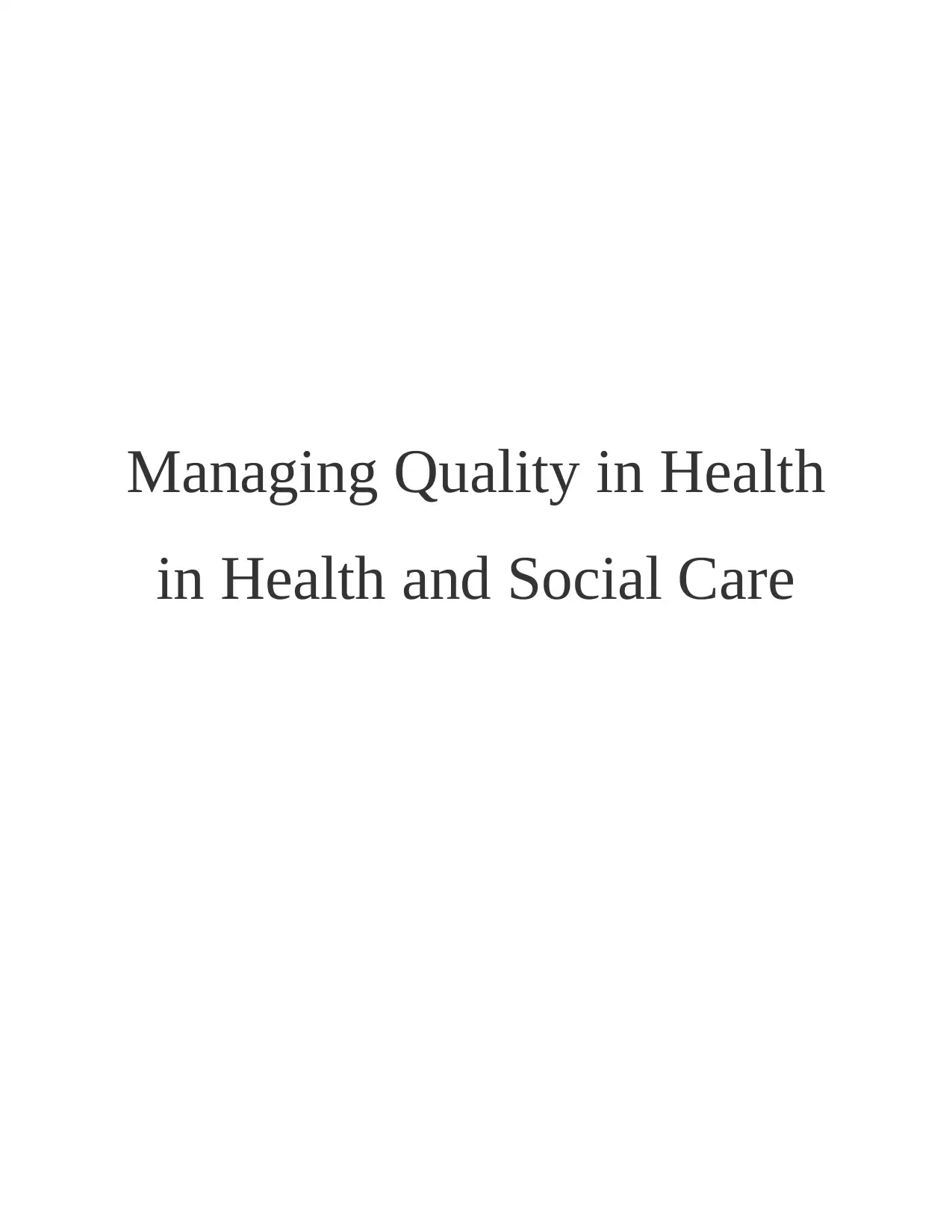
Managing Quality in Health
in Health and Social Care
in Health and Social Care
Secure Best Marks with AI Grader
Need help grading? Try our AI Grader for instant feedback on your assignments.
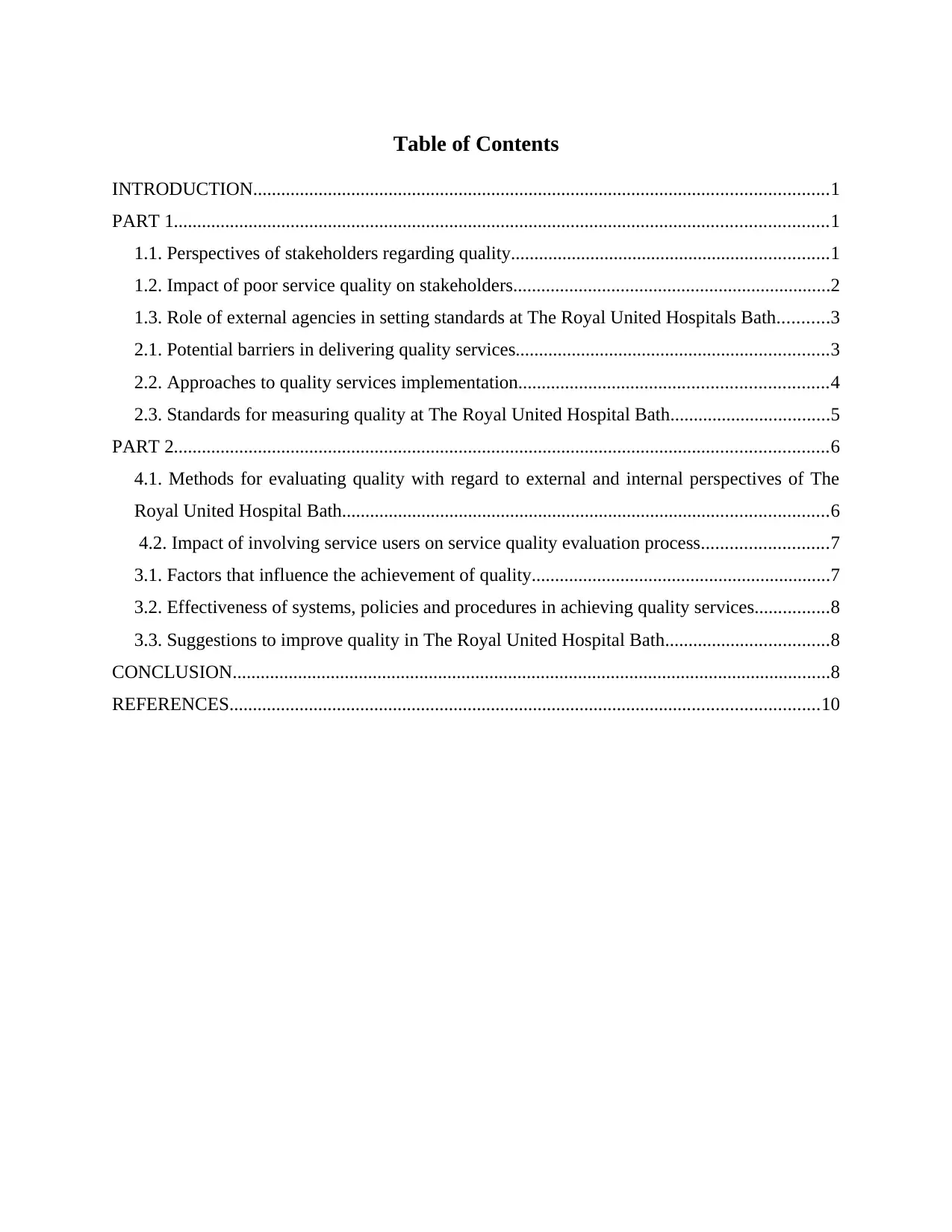
Table of Contents
INTRODUCTION...........................................................................................................................1
PART 1............................................................................................................................................1
1.1. Perspectives of stakeholders regarding quality....................................................................1
1.2. Impact of poor service quality on stakeholders....................................................................2
1.3. Role of external agencies in setting standards at The Royal United Hospitals Bath...........3
2.1. Potential barriers in delivering quality services...................................................................3
2.2. Approaches to quality services implementation..................................................................4
2.3. Standards for measuring quality at The Royal United Hospital Bath..................................5
PART 2............................................................................................................................................6
4.1. Methods for evaluating quality with regard to external and internal perspectives of The
Royal United Hospital Bath........................................................................................................6
4.2. Impact of involving service users on service quality evaluation process...........................7
3.1. Factors that influence the achievement of quality................................................................7
3.2. Effectiveness of systems, policies and procedures in achieving quality services................8
3.3. Suggestions to improve quality in The Royal United Hospital Bath...................................8
CONCLUSION................................................................................................................................8
REFERENCES..............................................................................................................................10
INTRODUCTION...........................................................................................................................1
PART 1............................................................................................................................................1
1.1. Perspectives of stakeholders regarding quality....................................................................1
1.2. Impact of poor service quality on stakeholders....................................................................2
1.3. Role of external agencies in setting standards at The Royal United Hospitals Bath...........3
2.1. Potential barriers in delivering quality services...................................................................3
2.2. Approaches to quality services implementation..................................................................4
2.3. Standards for measuring quality at The Royal United Hospital Bath..................................5
PART 2............................................................................................................................................6
4.1. Methods for evaluating quality with regard to external and internal perspectives of The
Royal United Hospital Bath........................................................................................................6
4.2. Impact of involving service users on service quality evaluation process...........................7
3.1. Factors that influence the achievement of quality................................................................7
3.2. Effectiveness of systems, policies and procedures in achieving quality services................8
3.3. Suggestions to improve quality in The Royal United Hospital Bath...................................8
CONCLUSION................................................................................................................................8
REFERENCES..............................................................................................................................10
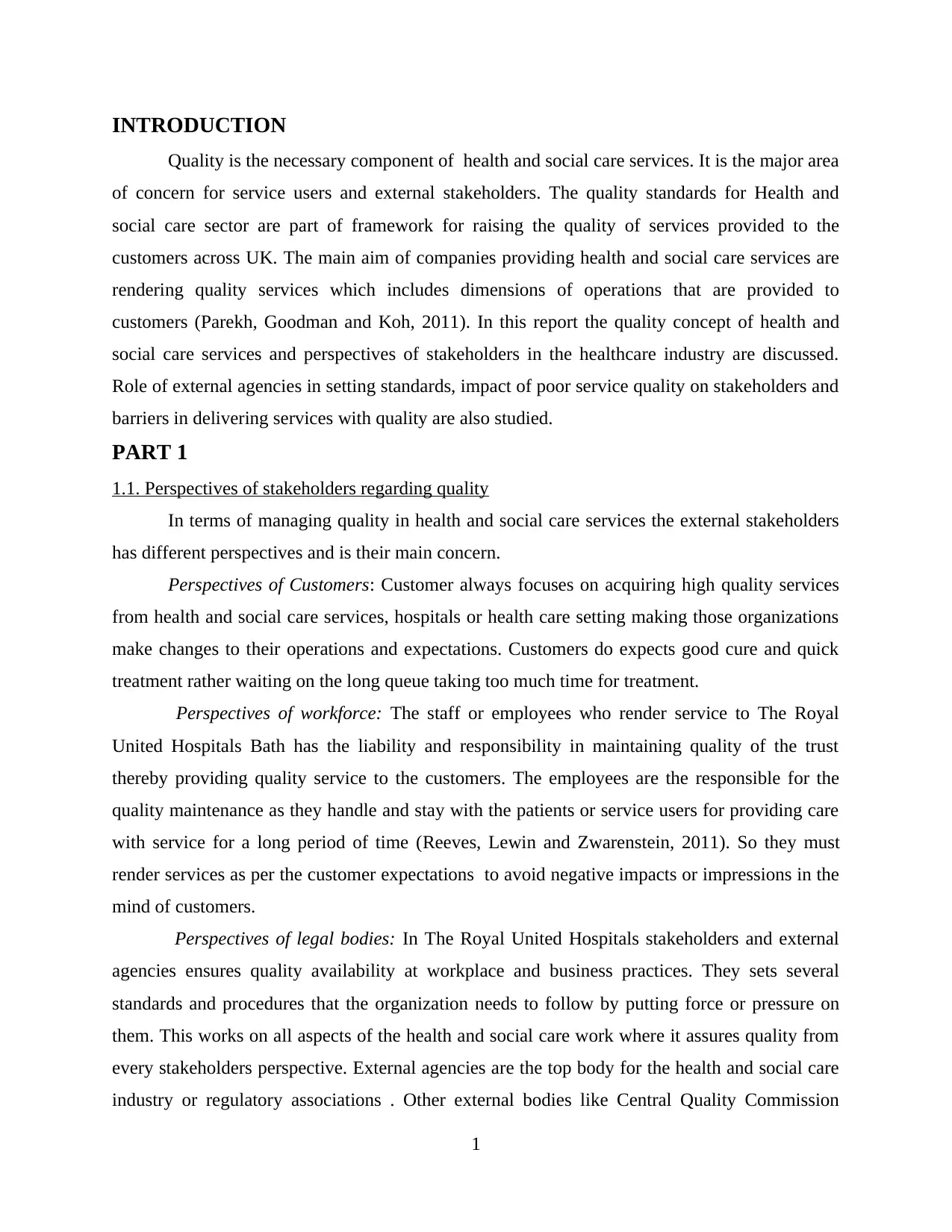
INTRODUCTION
Quality is the necessary component of health and social care services. It is the major area
of concern for service users and external stakeholders. The quality standards for Health and
social care sector are part of framework for raising the quality of services provided to the
customers across UK. The main aim of companies providing health and social care services are
rendering quality services which includes dimensions of operations that are provided to
customers (Parekh, Goodman and Koh, 2011). In this report the quality concept of health and
social care services and perspectives of stakeholders in the healthcare industry are discussed.
Role of external agencies in setting standards, impact of poor service quality on stakeholders and
barriers in delivering services with quality are also studied.
PART 1
1.1. Perspectives of stakeholders regarding quality
In terms of managing quality in health and social care services the external stakeholders
has different perspectives and is their main concern.
Perspectives of Customers: Customer always focuses on acquiring high quality services
from health and social care services, hospitals or health care setting making those organizations
make changes to their operations and expectations. Customers do expects good cure and quick
treatment rather waiting on the long queue taking too much time for treatment.
Perspectives of workforce: The staff or employees who render service to The Royal
United Hospitals Bath has the liability and responsibility in maintaining quality of the trust
thereby providing quality service to the customers. The employees are the responsible for the
quality maintenance as they handle and stay with the patients or service users for providing care
with service for a long period of time (Reeves, Lewin and Zwarenstein, 2011). So they must
render services as per the customer expectations to avoid negative impacts or impressions in the
mind of customers.
Perspectives of legal bodies: In The Royal United Hospitals stakeholders and external
agencies ensures quality availability at workplace and business practices. They sets several
standards and procedures that the organization needs to follow by putting force or pressure on
them. This works on all aspects of the health and social care work where it assures quality from
every stakeholders perspective. External agencies are the top body for the health and social care
industry or regulatory associations . Other external bodies like Central Quality Commission
1
Quality is the necessary component of health and social care services. It is the major area
of concern for service users and external stakeholders. The quality standards for Health and
social care sector are part of framework for raising the quality of services provided to the
customers across UK. The main aim of companies providing health and social care services are
rendering quality services which includes dimensions of operations that are provided to
customers (Parekh, Goodman and Koh, 2011). In this report the quality concept of health and
social care services and perspectives of stakeholders in the healthcare industry are discussed.
Role of external agencies in setting standards, impact of poor service quality on stakeholders and
barriers in delivering services with quality are also studied.
PART 1
1.1. Perspectives of stakeholders regarding quality
In terms of managing quality in health and social care services the external stakeholders
has different perspectives and is their main concern.
Perspectives of Customers: Customer always focuses on acquiring high quality services
from health and social care services, hospitals or health care setting making those organizations
make changes to their operations and expectations. Customers do expects good cure and quick
treatment rather waiting on the long queue taking too much time for treatment.
Perspectives of workforce: The staff or employees who render service to The Royal
United Hospitals Bath has the liability and responsibility in maintaining quality of the trust
thereby providing quality service to the customers. The employees are the responsible for the
quality maintenance as they handle and stay with the patients or service users for providing care
with service for a long period of time (Reeves, Lewin and Zwarenstein, 2011). So they must
render services as per the customer expectations to avoid negative impacts or impressions in the
mind of customers.
Perspectives of legal bodies: In The Royal United Hospitals stakeholders and external
agencies ensures quality availability at workplace and business practices. They sets several
standards and procedures that the organization needs to follow by putting force or pressure on
them. This works on all aspects of the health and social care work where it assures quality from
every stakeholders perspective. External agencies are the top body for the health and social care
industry or regulatory associations . Other external bodies like Central Quality Commission
1
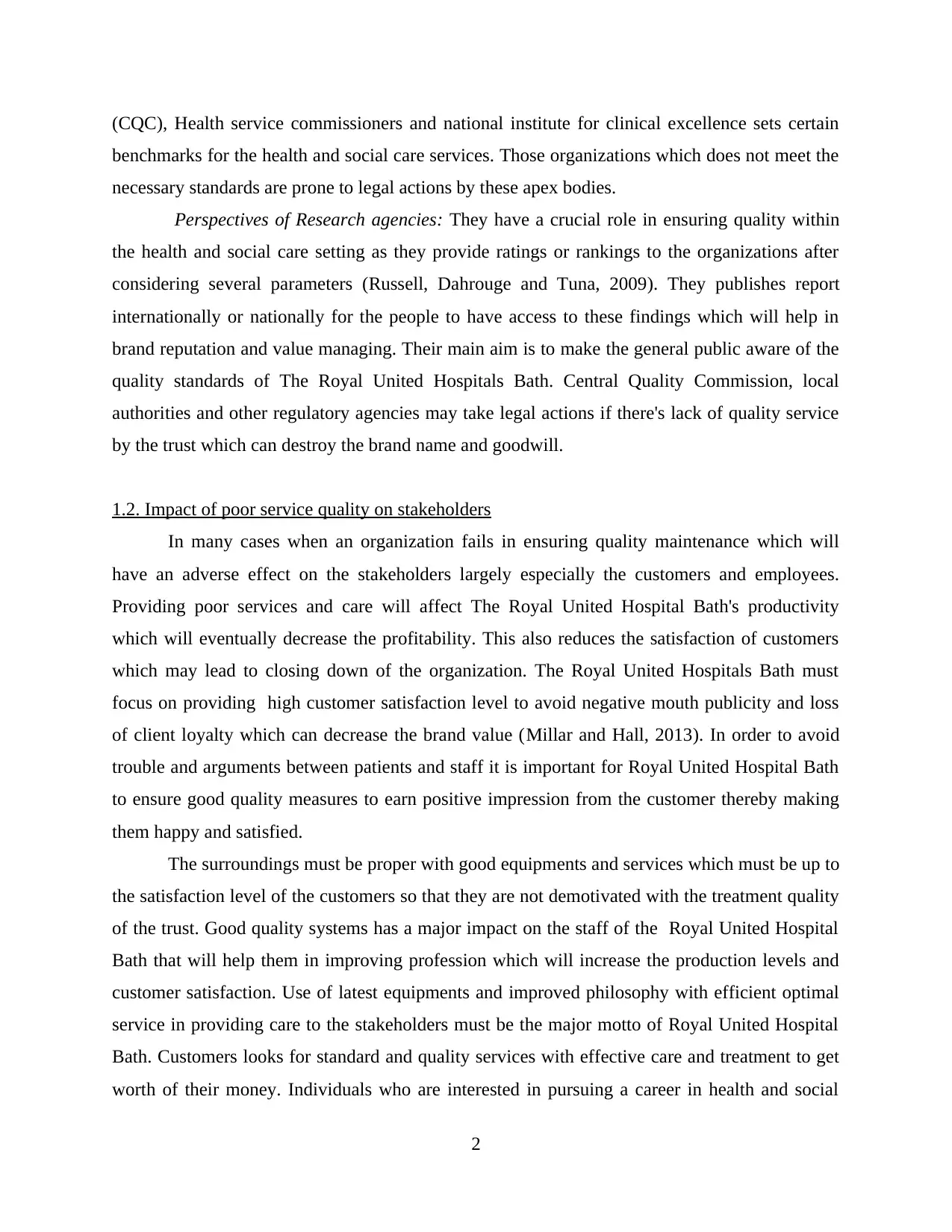
(CQC), Health service commissioners and national institute for clinical excellence sets certain
benchmarks for the health and social care services. Those organizations which does not meet the
necessary standards are prone to legal actions by these apex bodies.
Perspectives of Research agencies: They have a crucial role in ensuring quality within
the health and social care setting as they provide ratings or rankings to the organizations after
considering several parameters (Russell, Dahrouge and Tuna, 2009). They publishes report
internationally or nationally for the people to have access to these findings which will help in
brand reputation and value managing. Their main aim is to make the general public aware of the
quality standards of The Royal United Hospitals Bath. Central Quality Commission, local
authorities and other regulatory agencies may take legal actions if there's lack of quality service
by the trust which can destroy the brand name and goodwill.
1.2. Impact of poor service quality on stakeholders
In many cases when an organization fails in ensuring quality maintenance which will
have an adverse effect on the stakeholders largely especially the customers and employees.
Providing poor services and care will affect The Royal United Hospital Bath's productivity
which will eventually decrease the profitability. This also reduces the satisfaction of customers
which may lead to closing down of the organization. The Royal United Hospitals Bath must
focus on providing high customer satisfaction level to avoid negative mouth publicity and loss
of client loyalty which can decrease the brand value (Millar and Hall, 2013). In order to avoid
trouble and arguments between patients and staff it is important for Royal United Hospital Bath
to ensure good quality measures to earn positive impression from the customer thereby making
them happy and satisfied.
The surroundings must be proper with good equipments and services which must be up to
the satisfaction level of the customers so that they are not demotivated with the treatment quality
of the trust. Good quality systems has a major impact on the staff of the Royal United Hospital
Bath that will help them in improving profession which will increase the production levels and
customer satisfaction. Use of latest equipments and improved philosophy with efficient optimal
service in providing care to the stakeholders must be the major motto of Royal United Hospital
Bath. Customers looks for standard and quality services with effective care and treatment to get
worth of their money. Individuals who are interested in pursuing a career in health and social
2
benchmarks for the health and social care services. Those organizations which does not meet the
necessary standards are prone to legal actions by these apex bodies.
Perspectives of Research agencies: They have a crucial role in ensuring quality within
the health and social care setting as they provide ratings or rankings to the organizations after
considering several parameters (Russell, Dahrouge and Tuna, 2009). They publishes report
internationally or nationally for the people to have access to these findings which will help in
brand reputation and value managing. Their main aim is to make the general public aware of the
quality standards of The Royal United Hospitals Bath. Central Quality Commission, local
authorities and other regulatory agencies may take legal actions if there's lack of quality service
by the trust which can destroy the brand name and goodwill.
1.2. Impact of poor service quality on stakeholders
In many cases when an organization fails in ensuring quality maintenance which will
have an adverse effect on the stakeholders largely especially the customers and employees.
Providing poor services and care will affect The Royal United Hospital Bath's productivity
which will eventually decrease the profitability. This also reduces the satisfaction of customers
which may lead to closing down of the organization. The Royal United Hospitals Bath must
focus on providing high customer satisfaction level to avoid negative mouth publicity and loss
of client loyalty which can decrease the brand value (Millar and Hall, 2013). In order to avoid
trouble and arguments between patients and staff it is important for Royal United Hospital Bath
to ensure good quality measures to earn positive impression from the customer thereby making
them happy and satisfied.
The surroundings must be proper with good equipments and services which must be up to
the satisfaction level of the customers so that they are not demotivated with the treatment quality
of the trust. Good quality systems has a major impact on the staff of the Royal United Hospital
Bath that will help them in improving profession which will increase the production levels and
customer satisfaction. Use of latest equipments and improved philosophy with efficient optimal
service in providing care to the stakeholders must be the major motto of Royal United Hospital
Bath. Customers looks for standard and quality services with effective care and treatment to get
worth of their money. Individuals who are interested in pursuing a career in health and social
2
Secure Best Marks with AI Grader
Need help grading? Try our AI Grader for instant feedback on your assignments.
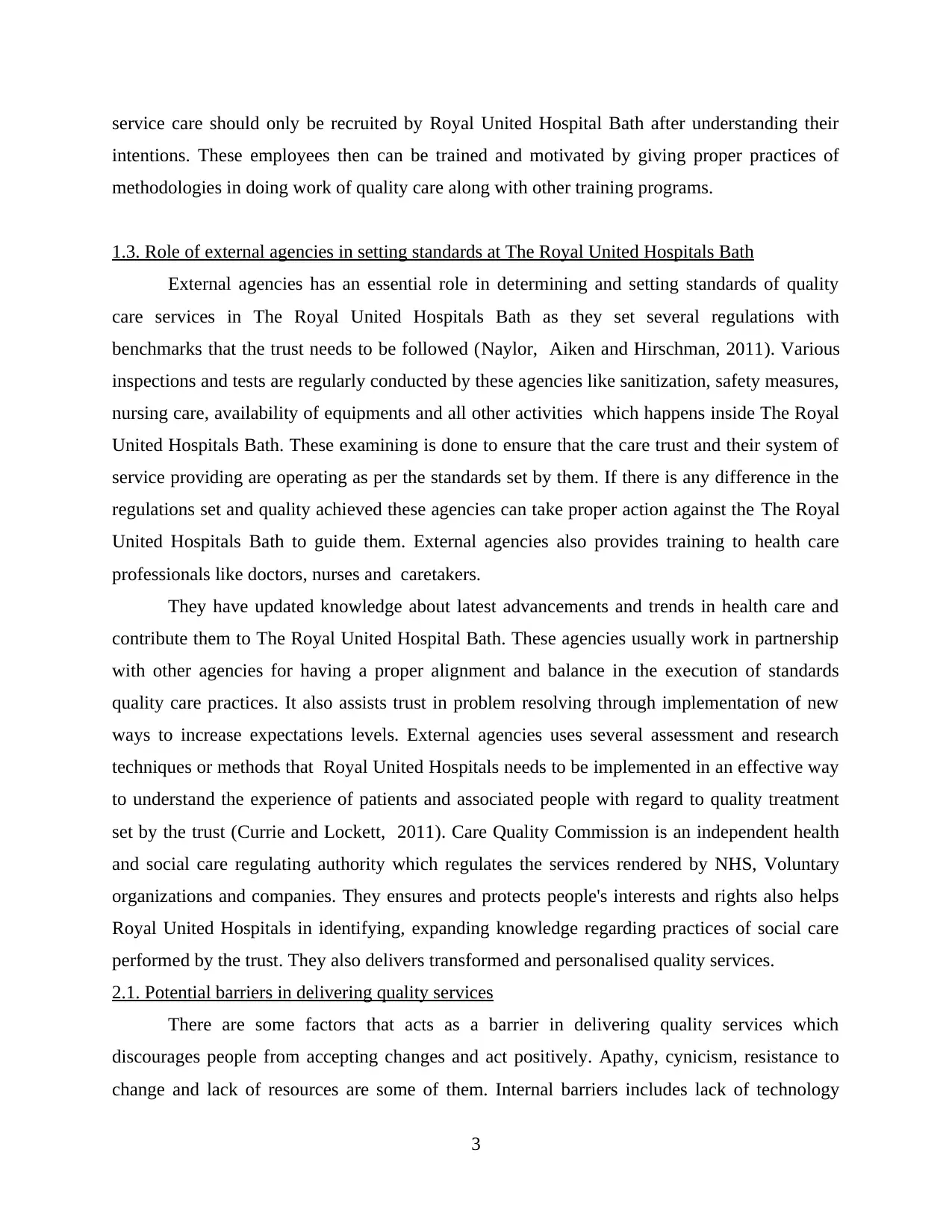
service care should only be recruited by Royal United Hospital Bath after understanding their
intentions. These employees then can be trained and motivated by giving proper practices of
methodologies in doing work of quality care along with other training programs.
1.3. Role of external agencies in setting standards at The Royal United Hospitals Bath
External agencies has an essential role in determining and setting standards of quality
care services in The Royal United Hospitals Bath as they set several regulations with
benchmarks that the trust needs to be followed (Naylor, Aiken and Hirschman, 2011). Various
inspections and tests are regularly conducted by these agencies like sanitization, safety measures,
nursing care, availability of equipments and all other activities which happens inside The Royal
United Hospitals Bath. These examining is done to ensure that the care trust and their system of
service providing are operating as per the standards set by them. If there is any difference in the
regulations set and quality achieved these agencies can take proper action against the The Royal
United Hospitals Bath to guide them. External agencies also provides training to health care
professionals like doctors, nurses and caretakers.
They have updated knowledge about latest advancements and trends in health care and
contribute them to The Royal United Hospital Bath. These agencies usually work in partnership
with other agencies for having a proper alignment and balance in the execution of standards
quality care practices. It also assists trust in problem resolving through implementation of new
ways to increase expectations levels. External agencies uses several assessment and research
techniques or methods that Royal United Hospitals needs to be implemented in an effective way
to understand the experience of patients and associated people with regard to quality treatment
set by the trust (Currie and Lockett, 2011). Care Quality Commission is an independent health
and social care regulating authority which regulates the services rendered by NHS, Voluntary
organizations and companies. They ensures and protects people's interests and rights also helps
Royal United Hospitals in identifying, expanding knowledge regarding practices of social care
performed by the trust. They also delivers transformed and personalised quality services.
2.1. Potential barriers in delivering quality services
There are some factors that acts as a barrier in delivering quality services which
discourages people from accepting changes and act positively. Apathy, cynicism, resistance to
change and lack of resources are some of them. Internal barriers includes lack of technology
3
intentions. These employees then can be trained and motivated by giving proper practices of
methodologies in doing work of quality care along with other training programs.
1.3. Role of external agencies in setting standards at The Royal United Hospitals Bath
External agencies has an essential role in determining and setting standards of quality
care services in The Royal United Hospitals Bath as they set several regulations with
benchmarks that the trust needs to be followed (Naylor, Aiken and Hirschman, 2011). Various
inspections and tests are regularly conducted by these agencies like sanitization, safety measures,
nursing care, availability of equipments and all other activities which happens inside The Royal
United Hospitals Bath. These examining is done to ensure that the care trust and their system of
service providing are operating as per the standards set by them. If there is any difference in the
regulations set and quality achieved these agencies can take proper action against the The Royal
United Hospitals Bath to guide them. External agencies also provides training to health care
professionals like doctors, nurses and caretakers.
They have updated knowledge about latest advancements and trends in health care and
contribute them to The Royal United Hospital Bath. These agencies usually work in partnership
with other agencies for having a proper alignment and balance in the execution of standards
quality care practices. It also assists trust in problem resolving through implementation of new
ways to increase expectations levels. External agencies uses several assessment and research
techniques or methods that Royal United Hospitals needs to be implemented in an effective way
to understand the experience of patients and associated people with regard to quality treatment
set by the trust (Currie and Lockett, 2011). Care Quality Commission is an independent health
and social care regulating authority which regulates the services rendered by NHS, Voluntary
organizations and companies. They ensures and protects people's interests and rights also helps
Royal United Hospitals in identifying, expanding knowledge regarding practices of social care
performed by the trust. They also delivers transformed and personalised quality services.
2.1. Potential barriers in delivering quality services
There are some factors that acts as a barrier in delivering quality services which
discourages people from accepting changes and act positively. Apathy, cynicism, resistance to
change and lack of resources are some of them. Internal barriers includes lack of technology
3
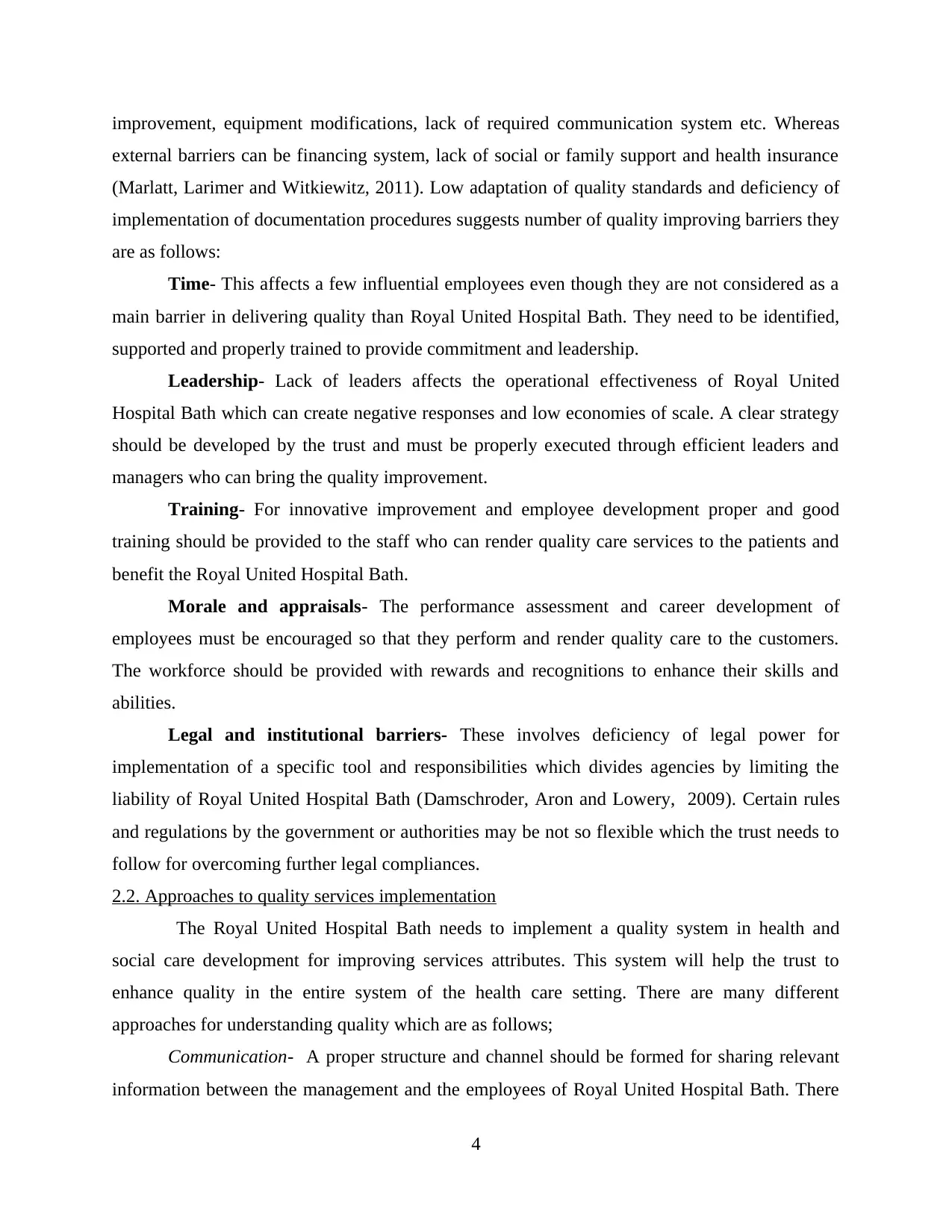
improvement, equipment modifications, lack of required communication system etc. Whereas
external barriers can be financing system, lack of social or family support and health insurance
(Marlatt, Larimer and Witkiewitz, 2011). Low adaptation of quality standards and deficiency of
implementation of documentation procedures suggests number of quality improving barriers they
are as follows:
Time- This affects a few influential employees even though they are not considered as a
main barrier in delivering quality than Royal United Hospital Bath. They need to be identified,
supported and properly trained to provide commitment and leadership.
Leadership- Lack of leaders affects the operational effectiveness of Royal United
Hospital Bath which can create negative responses and low economies of scale. A clear strategy
should be developed by the trust and must be properly executed through efficient leaders and
managers who can bring the quality improvement.
Training- For innovative improvement and employee development proper and good
training should be provided to the staff who can render quality care services to the patients and
benefit the Royal United Hospital Bath.
Morale and appraisals- The performance assessment and career development of
employees must be encouraged so that they perform and render quality care to the customers.
The workforce should be provided with rewards and recognitions to enhance their skills and
abilities.
Legal and institutional barriers- These involves deficiency of legal power for
implementation of a specific tool and responsibilities which divides agencies by limiting the
liability of Royal United Hospital Bath (Damschroder, Aron and Lowery, 2009). Certain rules
and regulations by the government or authorities may be not so flexible which the trust needs to
follow for overcoming further legal compliances.
2.2. Approaches to quality services implementation
The Royal United Hospital Bath needs to implement a quality system in health and
social care development for improving services attributes. This system will help the trust to
enhance quality in the entire system of the health care setting. There are many different
approaches for understanding quality which are as follows;
Communication- A proper structure and channel should be formed for sharing relevant
information between the management and the employees of Royal United Hospital Bath. There
4
external barriers can be financing system, lack of social or family support and health insurance
(Marlatt, Larimer and Witkiewitz, 2011). Low adaptation of quality standards and deficiency of
implementation of documentation procedures suggests number of quality improving barriers they
are as follows:
Time- This affects a few influential employees even though they are not considered as a
main barrier in delivering quality than Royal United Hospital Bath. They need to be identified,
supported and properly trained to provide commitment and leadership.
Leadership- Lack of leaders affects the operational effectiveness of Royal United
Hospital Bath which can create negative responses and low economies of scale. A clear strategy
should be developed by the trust and must be properly executed through efficient leaders and
managers who can bring the quality improvement.
Training- For innovative improvement and employee development proper and good
training should be provided to the staff who can render quality care services to the patients and
benefit the Royal United Hospital Bath.
Morale and appraisals- The performance assessment and career development of
employees must be encouraged so that they perform and render quality care to the customers.
The workforce should be provided with rewards and recognitions to enhance their skills and
abilities.
Legal and institutional barriers- These involves deficiency of legal power for
implementation of a specific tool and responsibilities which divides agencies by limiting the
liability of Royal United Hospital Bath (Damschroder, Aron and Lowery, 2009). Certain rules
and regulations by the government or authorities may be not so flexible which the trust needs to
follow for overcoming further legal compliances.
2.2. Approaches to quality services implementation
The Royal United Hospital Bath needs to implement a quality system in health and
social care development for improving services attributes. This system will help the trust to
enhance quality in the entire system of the health care setting. There are many different
approaches for understanding quality which are as follows;
Communication- A proper structure and channel should be formed for sharing relevant
information between the management and the employees of Royal United Hospital Bath. There
4
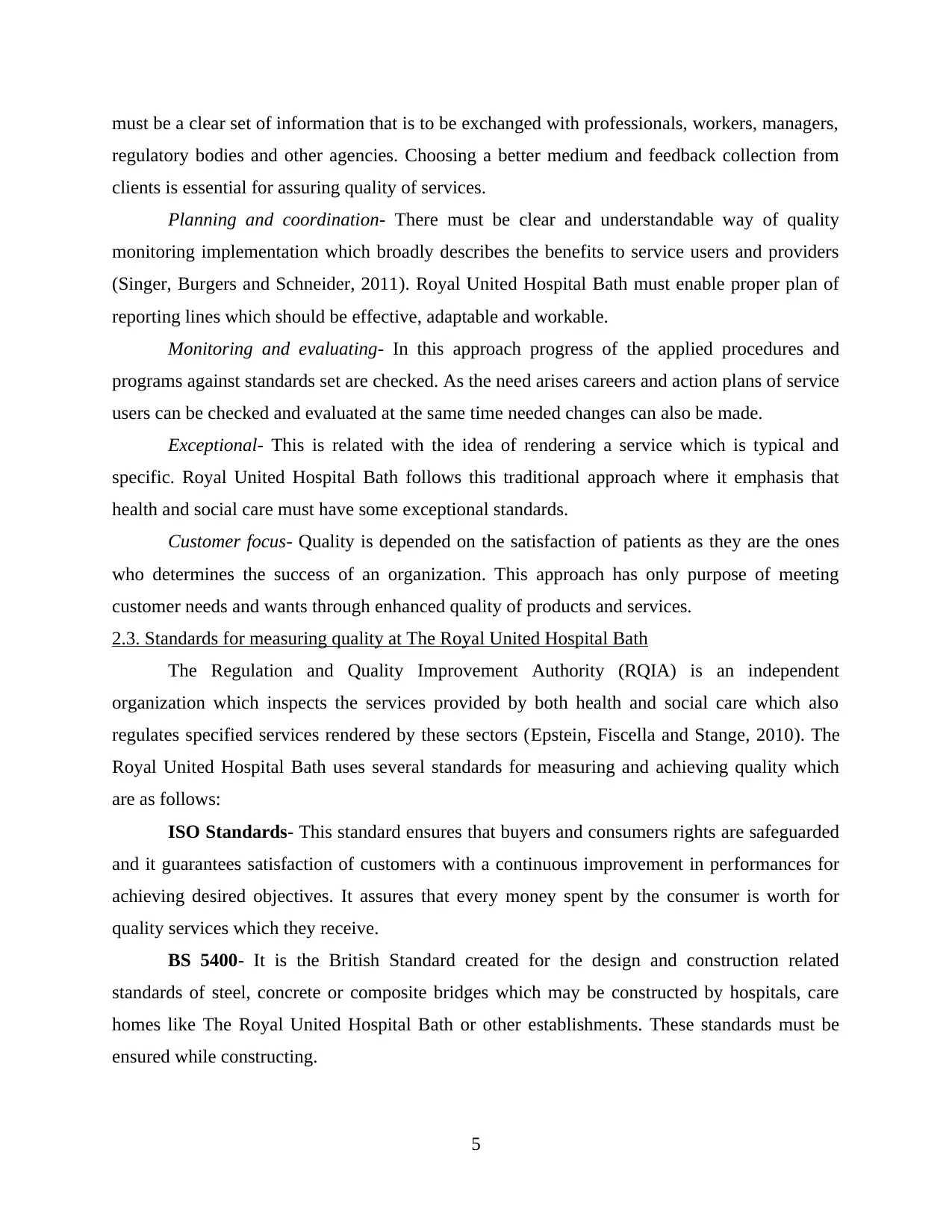
must be a clear set of information that is to be exchanged with professionals, workers, managers,
regulatory bodies and other agencies. Choosing a better medium and feedback collection from
clients is essential for assuring quality of services.
Planning and coordination- There must be clear and understandable way of quality
monitoring implementation which broadly describes the benefits to service users and providers
(Singer, Burgers and Schneider, 2011). Royal United Hospital Bath must enable proper plan of
reporting lines which should be effective, adaptable and workable.
Monitoring and evaluating- In this approach progress of the applied procedures and
programs against standards set are checked. As the need arises careers and action plans of service
users can be checked and evaluated at the same time needed changes can also be made.
Exceptional- This is related with the idea of rendering a service which is typical and
specific. Royal United Hospital Bath follows this traditional approach where it emphasis that
health and social care must have some exceptional standards.
Customer focus- Quality is depended on the satisfaction of patients as they are the ones
who determines the success of an organization. This approach has only purpose of meeting
customer needs and wants through enhanced quality of products and services.
2.3. Standards for measuring quality at The Royal United Hospital Bath
The Regulation and Quality Improvement Authority (RQIA) is an independent
organization which inspects the services provided by both health and social care which also
regulates specified services rendered by these sectors (Epstein, Fiscella and Stange, 2010). The
Royal United Hospital Bath uses several standards for measuring and achieving quality which
are as follows:
ISO Standards- This standard ensures that buyers and consumers rights are safeguarded
and it guarantees satisfaction of customers with a continuous improvement in performances for
achieving desired objectives. It assures that every money spent by the consumer is worth for
quality services which they receive.
BS 5400- It is the British Standard created for the design and construction related
standards of steel, concrete or composite bridges which may be constructed by hospitals, care
homes like The Royal United Hospital Bath or other establishments. These standards must be
ensured while constructing.
5
regulatory bodies and other agencies. Choosing a better medium and feedback collection from
clients is essential for assuring quality of services.
Planning and coordination- There must be clear and understandable way of quality
monitoring implementation which broadly describes the benefits to service users and providers
(Singer, Burgers and Schneider, 2011). Royal United Hospital Bath must enable proper plan of
reporting lines which should be effective, adaptable and workable.
Monitoring and evaluating- In this approach progress of the applied procedures and
programs against standards set are checked. As the need arises careers and action plans of service
users can be checked and evaluated at the same time needed changes can also be made.
Exceptional- This is related with the idea of rendering a service which is typical and
specific. Royal United Hospital Bath follows this traditional approach where it emphasis that
health and social care must have some exceptional standards.
Customer focus- Quality is depended on the satisfaction of patients as they are the ones
who determines the success of an organization. This approach has only purpose of meeting
customer needs and wants through enhanced quality of products and services.
2.3. Standards for measuring quality at The Royal United Hospital Bath
The Regulation and Quality Improvement Authority (RQIA) is an independent
organization which inspects the services provided by both health and social care which also
regulates specified services rendered by these sectors (Epstein, Fiscella and Stange, 2010). The
Royal United Hospital Bath uses several standards for measuring and achieving quality which
are as follows:
ISO Standards- This standard ensures that buyers and consumers rights are safeguarded
and it guarantees satisfaction of customers with a continuous improvement in performances for
achieving desired objectives. It assures that every money spent by the consumer is worth for
quality services which they receive.
BS 5400- It is the British Standard created for the design and construction related
standards of steel, concrete or composite bridges which may be constructed by hospitals, care
homes like The Royal United Hospital Bath or other establishments. These standards must be
ensured while constructing.
5
Paraphrase This Document
Need a fresh take? Get an instant paraphrase of this document with our AI Paraphraser
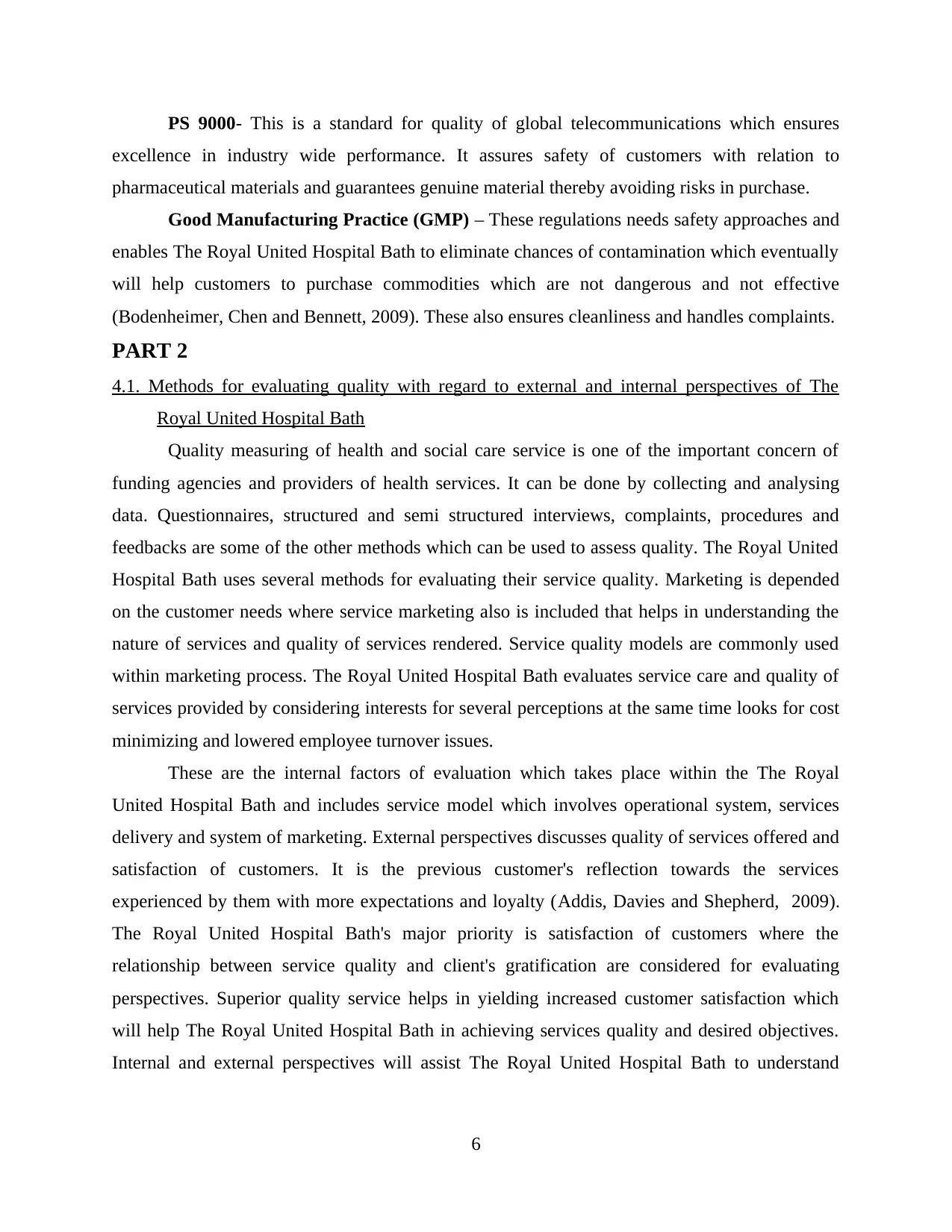
PS 9000- This is a standard for quality of global telecommunications which ensures
excellence in industry wide performance. It assures safety of customers with relation to
pharmaceutical materials and guarantees genuine material thereby avoiding risks in purchase.
Good Manufacturing Practice (GMP) – These regulations needs safety approaches and
enables The Royal United Hospital Bath to eliminate chances of contamination which eventually
will help customers to purchase commodities which are not dangerous and not effective
(Bodenheimer, Chen and Bennett, 2009). These also ensures cleanliness and handles complaints.
PART 2
4.1. Methods for evaluating quality with regard to external and internal perspectives of The
Royal United Hospital Bath
Quality measuring of health and social care service is one of the important concern of
funding agencies and providers of health services. It can be done by collecting and analysing
data. Questionnaires, structured and semi structured interviews, complaints, procedures and
feedbacks are some of the other methods which can be used to assess quality. The Royal United
Hospital Bath uses several methods for evaluating their service quality. Marketing is depended
on the customer needs where service marketing also is included that helps in understanding the
nature of services and quality of services rendered. Service quality models are commonly used
within marketing process. The Royal United Hospital Bath evaluates service care and quality of
services provided by considering interests for several perceptions at the same time looks for cost
minimizing and lowered employee turnover issues.
These are the internal factors of evaluation which takes place within the The Royal
United Hospital Bath and includes service model which involves operational system, services
delivery and system of marketing. External perspectives discusses quality of services offered and
satisfaction of customers. It is the previous customer's reflection towards the services
experienced by them with more expectations and loyalty (Addis, Davies and Shepherd, 2009).
The Royal United Hospital Bath's major priority is satisfaction of customers where the
relationship between service quality and client's gratification are considered for evaluating
perspectives. Superior quality service helps in yielding increased customer satisfaction which
will help The Royal United Hospital Bath in achieving services quality and desired objectives.
Internal and external perspectives will assist The Royal United Hospital Bath to understand
6
excellence in industry wide performance. It assures safety of customers with relation to
pharmaceutical materials and guarantees genuine material thereby avoiding risks in purchase.
Good Manufacturing Practice (GMP) – These regulations needs safety approaches and
enables The Royal United Hospital Bath to eliminate chances of contamination which eventually
will help customers to purchase commodities which are not dangerous and not effective
(Bodenheimer, Chen and Bennett, 2009). These also ensures cleanliness and handles complaints.
PART 2
4.1. Methods for evaluating quality with regard to external and internal perspectives of The
Royal United Hospital Bath
Quality measuring of health and social care service is one of the important concern of
funding agencies and providers of health services. It can be done by collecting and analysing
data. Questionnaires, structured and semi structured interviews, complaints, procedures and
feedbacks are some of the other methods which can be used to assess quality. The Royal United
Hospital Bath uses several methods for evaluating their service quality. Marketing is depended
on the customer needs where service marketing also is included that helps in understanding the
nature of services and quality of services rendered. Service quality models are commonly used
within marketing process. The Royal United Hospital Bath evaluates service care and quality of
services provided by considering interests for several perceptions at the same time looks for cost
minimizing and lowered employee turnover issues.
These are the internal factors of evaluation which takes place within the The Royal
United Hospital Bath and includes service model which involves operational system, services
delivery and system of marketing. External perspectives discusses quality of services offered and
satisfaction of customers. It is the previous customer's reflection towards the services
experienced by them with more expectations and loyalty (Addis, Davies and Shepherd, 2009).
The Royal United Hospital Bath's major priority is satisfaction of customers where the
relationship between service quality and client's gratification are considered for evaluating
perspectives. Superior quality service helps in yielding increased customer satisfaction which
will help The Royal United Hospital Bath in achieving services quality and desired objectives.
Internal and external perspectives will assist The Royal United Hospital Bath to understand
6
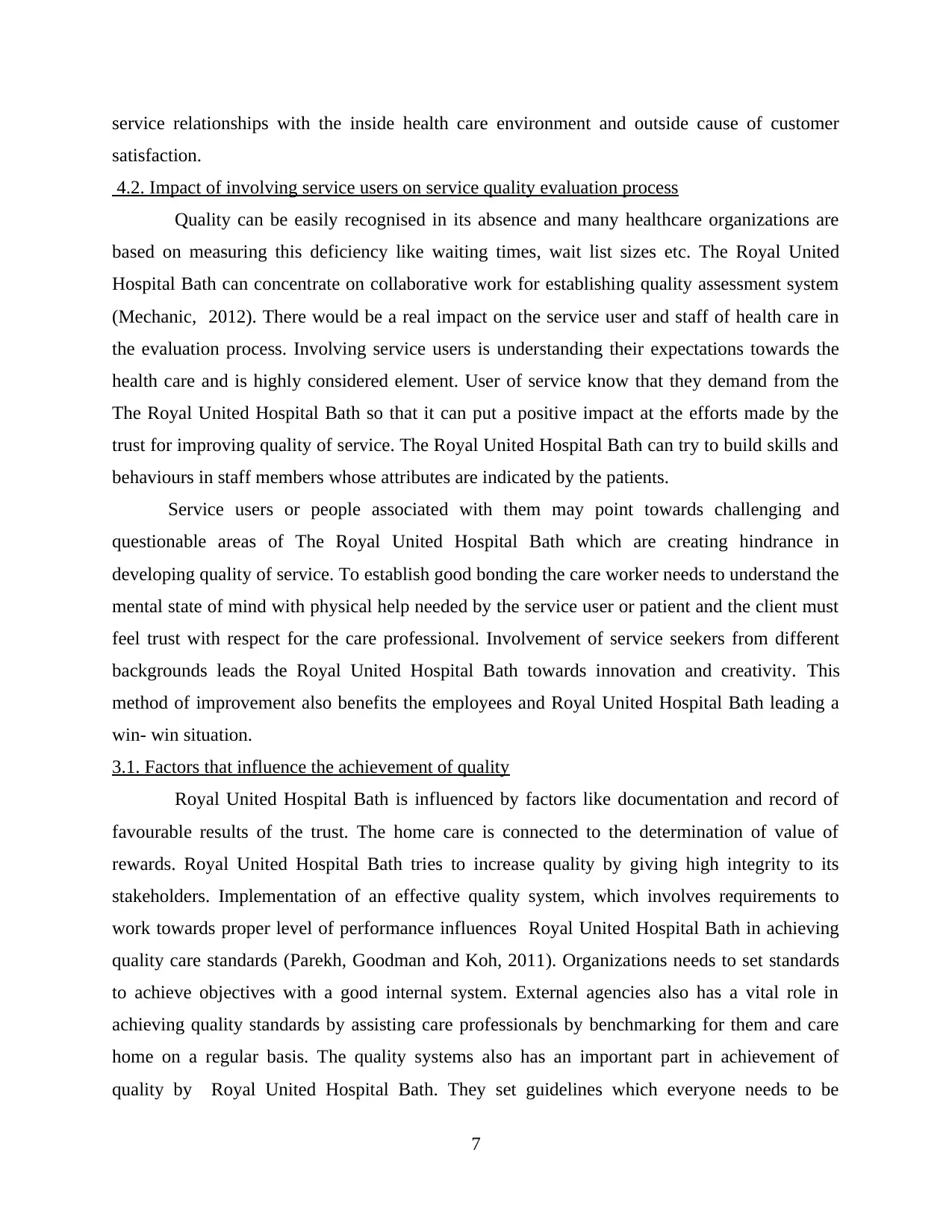
service relationships with the inside health care environment and outside cause of customer
satisfaction.
4.2. Impact of involving service users on service quality evaluation process
Quality can be easily recognised in its absence and many healthcare organizations are
based on measuring this deficiency like waiting times, wait list sizes etc. The Royal United
Hospital Bath can concentrate on collaborative work for establishing quality assessment system
(Mechanic, 2012). There would be a real impact on the service user and staff of health care in
the evaluation process. Involving service users is understanding their expectations towards the
health care and is highly considered element. User of service know that they demand from the
The Royal United Hospital Bath so that it can put a positive impact at the efforts made by the
trust for improving quality of service. The Royal United Hospital Bath can try to build skills and
behaviours in staff members whose attributes are indicated by the patients.
Service users or people associated with them may point towards challenging and
questionable areas of The Royal United Hospital Bath which are creating hindrance in
developing quality of service. To establish good bonding the care worker needs to understand the
mental state of mind with physical help needed by the service user or patient and the client must
feel trust with respect for the care professional. Involvement of service seekers from different
backgrounds leads the Royal United Hospital Bath towards innovation and creativity. This
method of improvement also benefits the employees and Royal United Hospital Bath leading a
win- win situation.
3.1. Factors that influence the achievement of quality
Royal United Hospital Bath is influenced by factors like documentation and record of
favourable results of the trust. The home care is connected to the determination of value of
rewards. Royal United Hospital Bath tries to increase quality by giving high integrity to its
stakeholders. Implementation of an effective quality system, which involves requirements to
work towards proper level of performance influences Royal United Hospital Bath in achieving
quality care standards (Parekh, Goodman and Koh, 2011). Organizations needs to set standards
to achieve objectives with a good internal system. External agencies also has a vital role in
achieving quality standards by assisting care professionals by benchmarking for them and care
home on a regular basis. The quality systems also has an important part in achievement of
quality by Royal United Hospital Bath. They set guidelines which everyone needs to be
7
satisfaction.
4.2. Impact of involving service users on service quality evaluation process
Quality can be easily recognised in its absence and many healthcare organizations are
based on measuring this deficiency like waiting times, wait list sizes etc. The Royal United
Hospital Bath can concentrate on collaborative work for establishing quality assessment system
(Mechanic, 2012). There would be a real impact on the service user and staff of health care in
the evaluation process. Involving service users is understanding their expectations towards the
health care and is highly considered element. User of service know that they demand from the
The Royal United Hospital Bath so that it can put a positive impact at the efforts made by the
trust for improving quality of service. The Royal United Hospital Bath can try to build skills and
behaviours in staff members whose attributes are indicated by the patients.
Service users or people associated with them may point towards challenging and
questionable areas of The Royal United Hospital Bath which are creating hindrance in
developing quality of service. To establish good bonding the care worker needs to understand the
mental state of mind with physical help needed by the service user or patient and the client must
feel trust with respect for the care professional. Involvement of service seekers from different
backgrounds leads the Royal United Hospital Bath towards innovation and creativity. This
method of improvement also benefits the employees and Royal United Hospital Bath leading a
win- win situation.
3.1. Factors that influence the achievement of quality
Royal United Hospital Bath is influenced by factors like documentation and record of
favourable results of the trust. The home care is connected to the determination of value of
rewards. Royal United Hospital Bath tries to increase quality by giving high integrity to its
stakeholders. Implementation of an effective quality system, which involves requirements to
work towards proper level of performance influences Royal United Hospital Bath in achieving
quality care standards (Parekh, Goodman and Koh, 2011). Organizations needs to set standards
to achieve objectives with a good internal system. External agencies also has a vital role in
achieving quality standards by assisting care professionals by benchmarking for them and care
home on a regular basis. The quality systems also has an important part in achievement of
quality by Royal United Hospital Bath. They set guidelines which everyone needs to be
7
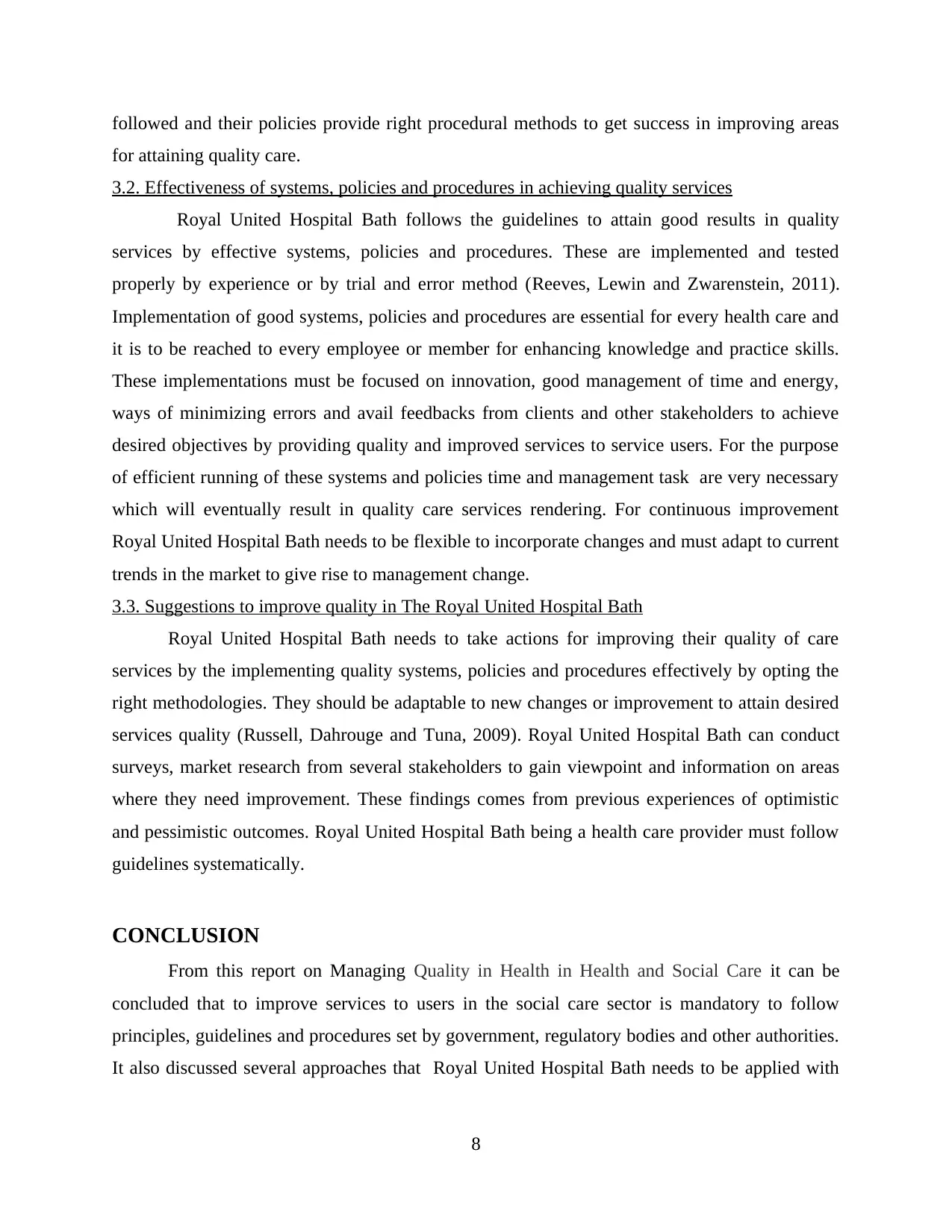
followed and their policies provide right procedural methods to get success in improving areas
for attaining quality care.
3.2. Effectiveness of systems, policies and procedures in achieving quality services
Royal United Hospital Bath follows the guidelines to attain good results in quality
services by effective systems, policies and procedures. These are implemented and tested
properly by experience or by trial and error method (Reeves, Lewin and Zwarenstein, 2011).
Implementation of good systems, policies and procedures are essential for every health care and
it is to be reached to every employee or member for enhancing knowledge and practice skills.
These implementations must be focused on innovation, good management of time and energy,
ways of minimizing errors and avail feedbacks from clients and other stakeholders to achieve
desired objectives by providing quality and improved services to service users. For the purpose
of efficient running of these systems and policies time and management task are very necessary
which will eventually result in quality care services rendering. For continuous improvement
Royal United Hospital Bath needs to be flexible to incorporate changes and must adapt to current
trends in the market to give rise to management change.
3.3. Suggestions to improve quality in The Royal United Hospital Bath
Royal United Hospital Bath needs to take actions for improving their quality of care
services by the implementing quality systems, policies and procedures effectively by opting the
right methodologies. They should be adaptable to new changes or improvement to attain desired
services quality (Russell, Dahrouge and Tuna, 2009). Royal United Hospital Bath can conduct
surveys, market research from several stakeholders to gain viewpoint and information on areas
where they need improvement. These findings comes from previous experiences of optimistic
and pessimistic outcomes. Royal United Hospital Bath being a health care provider must follow
guidelines systematically.
CONCLUSION
From this report on Managing Quality in Health in Health and Social Care it can be
concluded that to improve services to users in the social care sector is mandatory to follow
principles, guidelines and procedures set by government, regulatory bodies and other authorities.
It also discussed several approaches that Royal United Hospital Bath needs to be applied with
8
for attaining quality care.
3.2. Effectiveness of systems, policies and procedures in achieving quality services
Royal United Hospital Bath follows the guidelines to attain good results in quality
services by effective systems, policies and procedures. These are implemented and tested
properly by experience or by trial and error method (Reeves, Lewin and Zwarenstein, 2011).
Implementation of good systems, policies and procedures are essential for every health care and
it is to be reached to every employee or member for enhancing knowledge and practice skills.
These implementations must be focused on innovation, good management of time and energy,
ways of minimizing errors and avail feedbacks from clients and other stakeholders to achieve
desired objectives by providing quality and improved services to service users. For the purpose
of efficient running of these systems and policies time and management task are very necessary
which will eventually result in quality care services rendering. For continuous improvement
Royal United Hospital Bath needs to be flexible to incorporate changes and must adapt to current
trends in the market to give rise to management change.
3.3. Suggestions to improve quality in The Royal United Hospital Bath
Royal United Hospital Bath needs to take actions for improving their quality of care
services by the implementing quality systems, policies and procedures effectively by opting the
right methodologies. They should be adaptable to new changes or improvement to attain desired
services quality (Russell, Dahrouge and Tuna, 2009). Royal United Hospital Bath can conduct
surveys, market research from several stakeholders to gain viewpoint and information on areas
where they need improvement. These findings comes from previous experiences of optimistic
and pessimistic outcomes. Royal United Hospital Bath being a health care provider must follow
guidelines systematically.
CONCLUSION
From this report on Managing Quality in Health in Health and Social Care it can be
concluded that to improve services to users in the social care sector is mandatory to follow
principles, guidelines and procedures set by government, regulatory bodies and other authorities.
It also discussed several approaches that Royal United Hospital Bath needs to be applied with
8
Secure Best Marks with AI Grader
Need help grading? Try our AI Grader for instant feedback on your assignments.
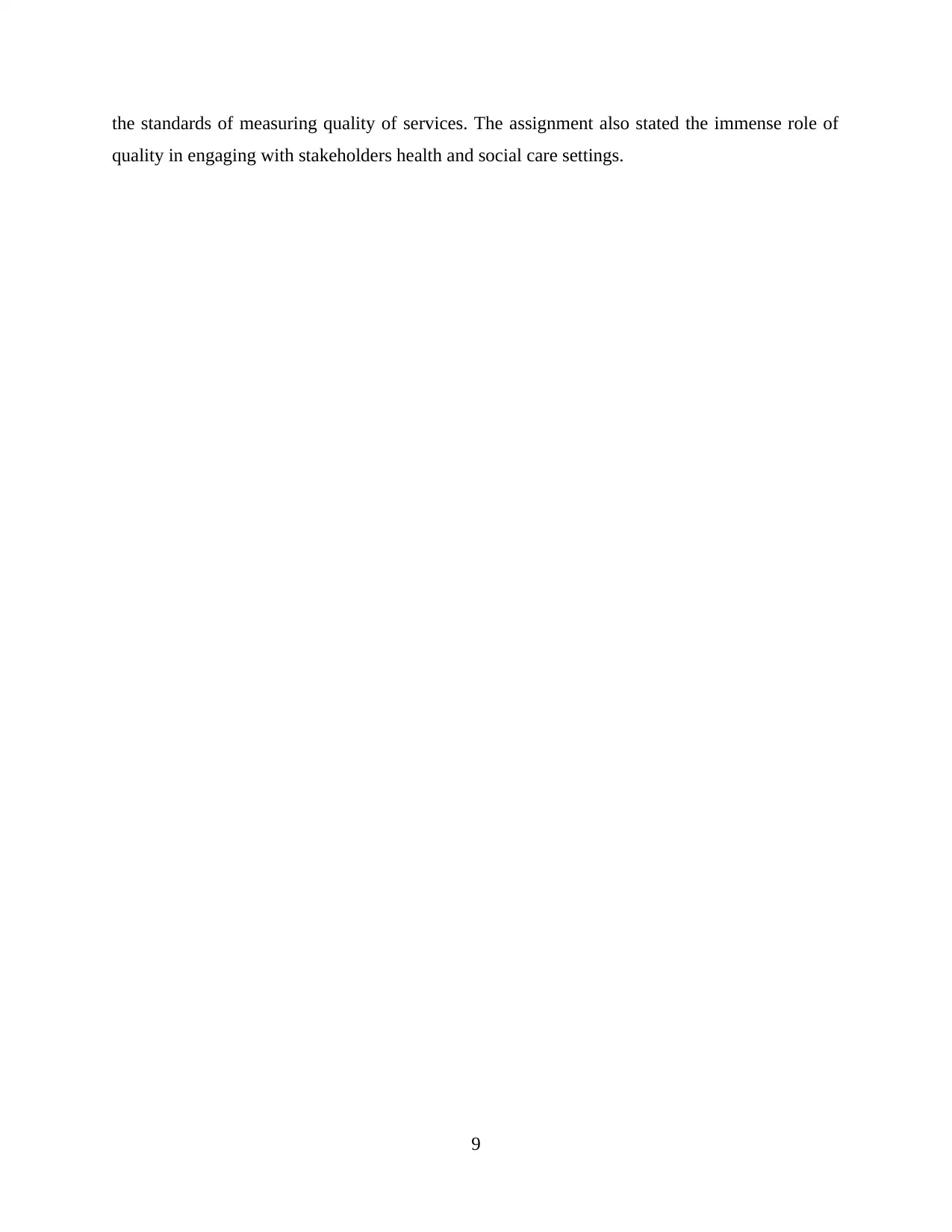
the standards of measuring quality of services. The assignment also stated the immense role of
quality in engaging with stakeholders health and social care settings.
9
quality in engaging with stakeholders health and social care settings.
9
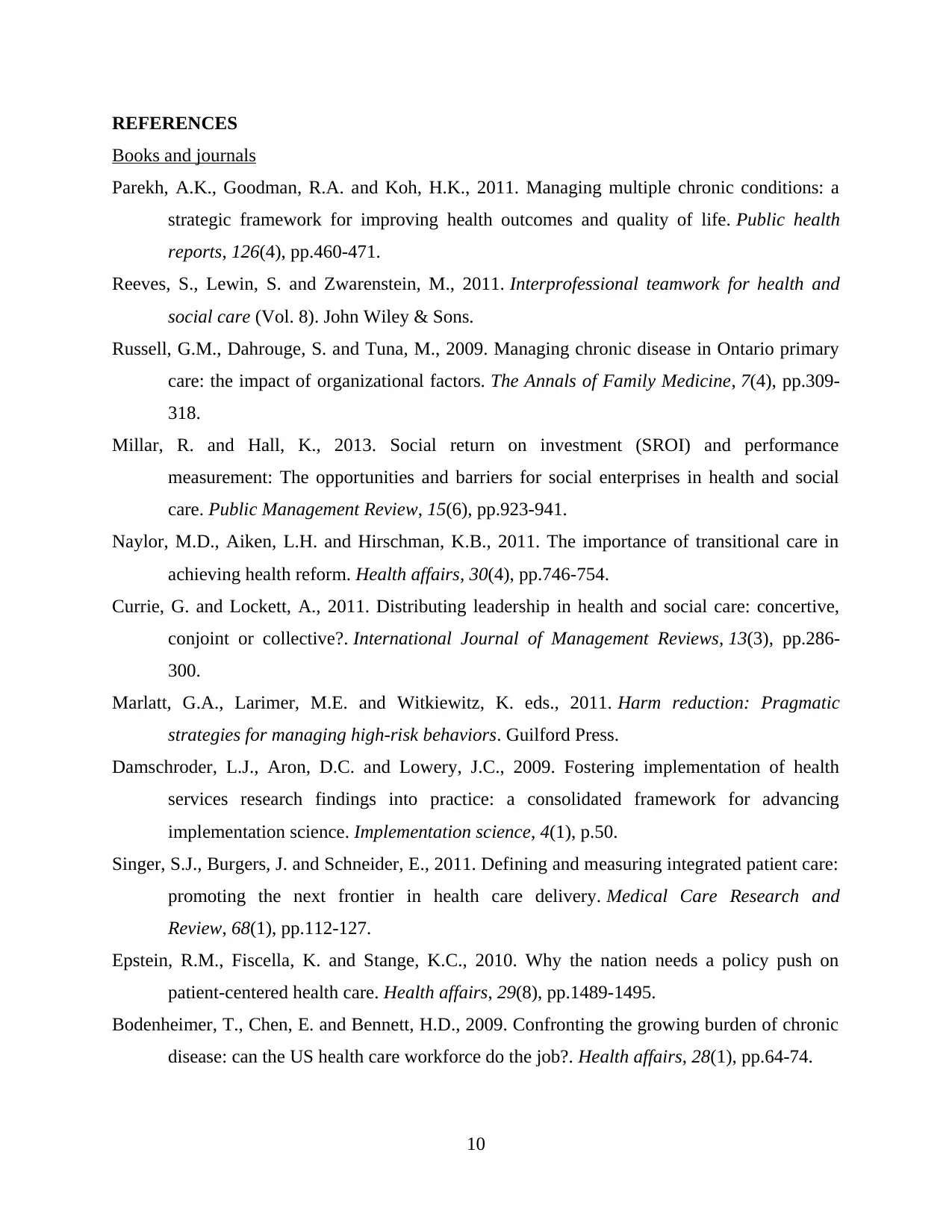
REFERENCES
Books and journals
Parekh, A.K., Goodman, R.A. and Koh, H.K., 2011. Managing multiple chronic conditions: a
strategic framework for improving health outcomes and quality of life. Public health
reports, 126(4), pp.460-471.
Reeves, S., Lewin, S. and Zwarenstein, M., 2011. Interprofessional teamwork for health and
social care (Vol. 8). John Wiley & Sons.
Russell, G.M., Dahrouge, S. and Tuna, M., 2009. Managing chronic disease in Ontario primary
care: the impact of organizational factors. The Annals of Family Medicine, 7(4), pp.309-
318.
Millar, R. and Hall, K., 2013. Social return on investment (SROI) and performance
measurement: The opportunities and barriers for social enterprises in health and social
care. Public Management Review, 15(6), pp.923-941.
Naylor, M.D., Aiken, L.H. and Hirschman, K.B., 2011. The importance of transitional care in
achieving health reform. Health affairs, 30(4), pp.746-754.
Currie, G. and Lockett, A., 2011. Distributing leadership in health and social care: concertive,
conjoint or collective?. International Journal of Management Reviews, 13(3), pp.286-
300.
Marlatt, G.A., Larimer, M.E. and Witkiewitz, K. eds., 2011. Harm reduction: Pragmatic
strategies for managing high-risk behaviors. Guilford Press.
Damschroder, L.J., Aron, D.C. and Lowery, J.C., 2009. Fostering implementation of health
services research findings into practice: a consolidated framework for advancing
implementation science. Implementation science, 4(1), p.50.
Singer, S.J., Burgers, J. and Schneider, E., 2011. Defining and measuring integrated patient care:
promoting the next frontier in health care delivery. Medical Care Research and
Review, 68(1), pp.112-127.
Epstein, R.M., Fiscella, K. and Stange, K.C., 2010. Why the nation needs a policy push on
patient-centered health care. Health affairs, 29(8), pp.1489-1495.
Bodenheimer, T., Chen, E. and Bennett, H.D., 2009. Confronting the growing burden of chronic
disease: can the US health care workforce do the job?. Health affairs, 28(1), pp.64-74.
10
Books and journals
Parekh, A.K., Goodman, R.A. and Koh, H.K., 2011. Managing multiple chronic conditions: a
strategic framework for improving health outcomes and quality of life. Public health
reports, 126(4), pp.460-471.
Reeves, S., Lewin, S. and Zwarenstein, M., 2011. Interprofessional teamwork for health and
social care (Vol. 8). John Wiley & Sons.
Russell, G.M., Dahrouge, S. and Tuna, M., 2009. Managing chronic disease in Ontario primary
care: the impact of organizational factors. The Annals of Family Medicine, 7(4), pp.309-
318.
Millar, R. and Hall, K., 2013. Social return on investment (SROI) and performance
measurement: The opportunities and barriers for social enterprises in health and social
care. Public Management Review, 15(6), pp.923-941.
Naylor, M.D., Aiken, L.H. and Hirschman, K.B., 2011. The importance of transitional care in
achieving health reform. Health affairs, 30(4), pp.746-754.
Currie, G. and Lockett, A., 2011. Distributing leadership in health and social care: concertive,
conjoint or collective?. International Journal of Management Reviews, 13(3), pp.286-
300.
Marlatt, G.A., Larimer, M.E. and Witkiewitz, K. eds., 2011. Harm reduction: Pragmatic
strategies for managing high-risk behaviors. Guilford Press.
Damschroder, L.J., Aron, D.C. and Lowery, J.C., 2009. Fostering implementation of health
services research findings into practice: a consolidated framework for advancing
implementation science. Implementation science, 4(1), p.50.
Singer, S.J., Burgers, J. and Schneider, E., 2011. Defining and measuring integrated patient care:
promoting the next frontier in health care delivery. Medical Care Research and
Review, 68(1), pp.112-127.
Epstein, R.M., Fiscella, K. and Stange, K.C., 2010. Why the nation needs a policy push on
patient-centered health care. Health affairs, 29(8), pp.1489-1495.
Bodenheimer, T., Chen, E. and Bennett, H.D., 2009. Confronting the growing burden of chronic
disease: can the US health care workforce do the job?. Health affairs, 28(1), pp.64-74.
10
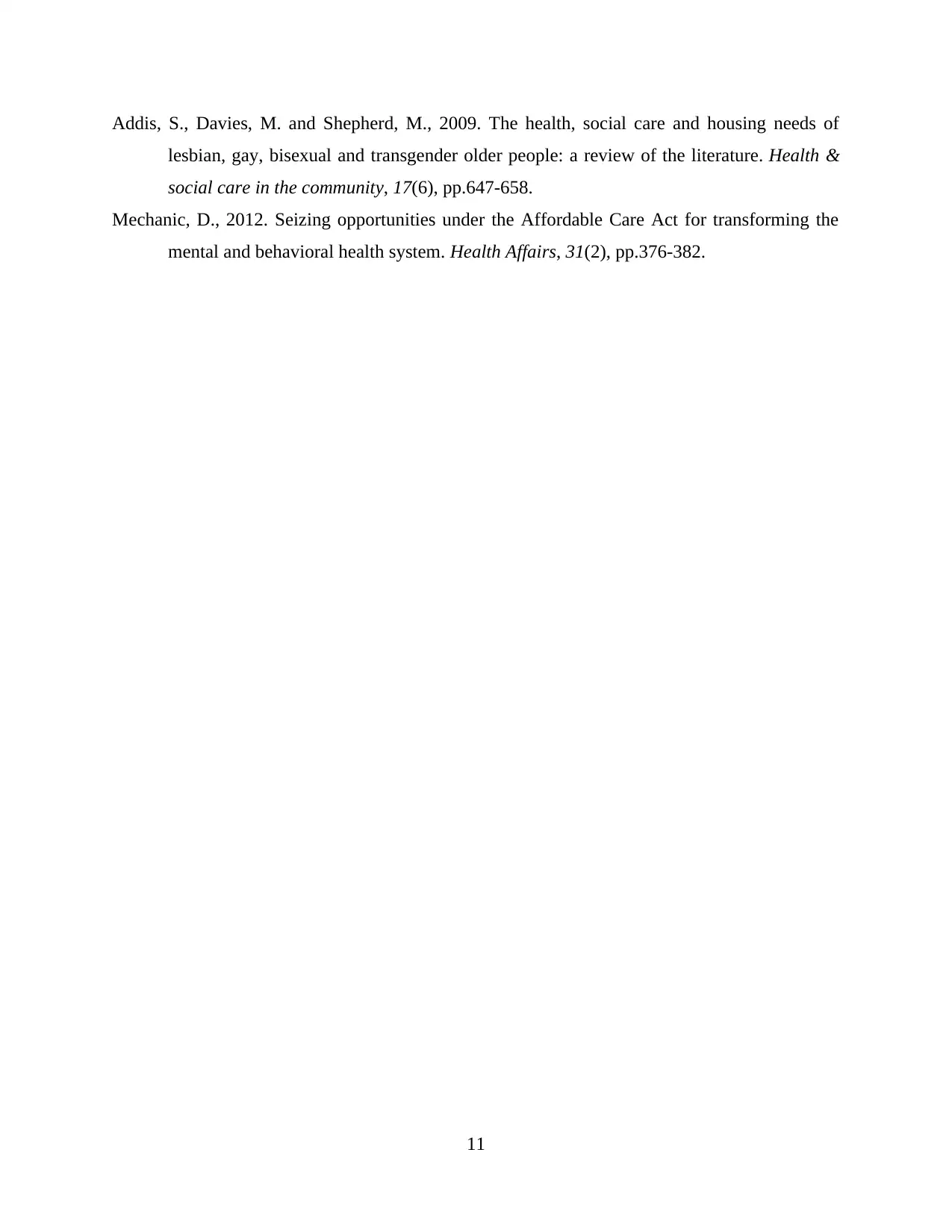
Addis, S., Davies, M. and Shepherd, M., 2009. The health, social care and housing needs of
lesbian, gay, bisexual and transgender older people: a review of the literature. Health &
social care in the community, 17(6), pp.647-658.
Mechanic, D., 2012. Seizing opportunities under the Affordable Care Act for transforming the
mental and behavioral health system. Health Affairs, 31(2), pp.376-382.
11
lesbian, gay, bisexual and transgender older people: a review of the literature. Health &
social care in the community, 17(6), pp.647-658.
Mechanic, D., 2012. Seizing opportunities under the Affordable Care Act for transforming the
mental and behavioral health system. Health Affairs, 31(2), pp.376-382.
11
1 out of 13
Related Documents
Your All-in-One AI-Powered Toolkit for Academic Success.
+13062052269
info@desklib.com
Available 24*7 on WhatsApp / Email
![[object Object]](/_next/static/media/star-bottom.7253800d.svg)
Unlock your academic potential
© 2024 | Zucol Services PVT LTD | All rights reserved.





